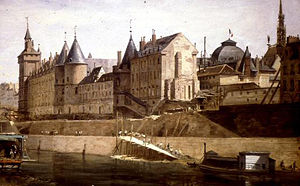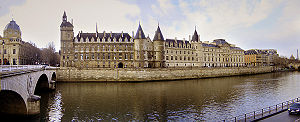
Conciergerie
Encyclopedia

Paris
Paris is the capital and largest city in France, situated on the river Seine, in northern France, at the heart of the Île-de-France region...
, France, located on the west of the Île de la Cité
Île de la Cité
The Île de la Cité is one of two remaining natural islands in the Seine within the city of Paris . It is the centre of Paris and the location where the medieval city was refounded....
, near the Cathedral of Notre-Dame. It is part of the larger complex known as the Palais de Justice, which is still used for judicial purposes. Hundreds of prisoners during the French Revolution were taken from La Conciergerie to be executed on the guillotine
Guillotine
The guillotine is a device used for carrying out :executions by decapitation. It consists of a tall upright frame from which an angled blade is suspended. This blade is raised with a rope and then allowed to drop, severing the head from the body...
at a number of locations around Paris.
The Middle Ages
Le Palais west part of the island was the site of a Merovingian palace; and from the 10th to the 14th centuries was the seat of the medieval Kings of France. Under Louis IXLouis IX of France
Louis IX , commonly Saint Louis, was King of France from 1226 until his death. He was also styled Louis II, Count of Artois from 1226 to 1237. Born at Poissy, near Paris, he was an eighth-generation descendant of Hugh Capet, and thus a member of the House of Capet, and the son of Louis VIII and...
(Saint Louis) (1226–1270) and Philip IV
Philip IV of France
Philip the Fair was, as Philip IV, King of France from 1285 until his death. He was the husband of Joan I of Navarre, by virtue of which he was, as Philip I, King of Navarre and Count of Champagne from 1284 to 1305.-Youth:A member of the House of Capet, Philip was born at the Palace of...
(Philip the Fair) (1284–1314) the Merovingian palace was extended and more heavily fortified.
Louis IX added the remarkable Sainte-Chapelle
Sainte-Chapelle
La Sainte-Chapelle is the only surviving building of the Capetian royal palace on the Île de la Cité in the heart of Paris, France. It was commissioned by King Louis IX of France to house his collection of Passion Relics, including the Crown of Thorns - one of the most important relics in medieval...
and associated galleries, while Philippe IV created the towered facade on the river side and a large hall. Both are excellent examples of French religious and secular architecture of the period. The Sainte-Chapelle
Sainte-Chapelle
La Sainte-Chapelle is the only surviving building of the Capetian royal palace on the Île de la Cité in the heart of Paris, France. It was commissioned by King Louis IX of France to house his collection of Passion Relics, including the Crown of Thorns - one of the most important relics in medieval...
, built in the French royal style, was erected to house the crown of thorns
Crown of Thorns
In Christianity, the Crown of Thorns, one of the instruments of the Passion, was woven of thorn branches and placed on Jesus Christ before his crucifixion...
brought back from the crusades, and to serve as royal chapel. The "Grand Salle" (Great Hall) was one of the largest in Europe, and its lower story, known as "La salle des gens d'armes" survives: 64 m long, 27.5 m wide and 8.5 m high. It was used as a dining-room for the 2,000 staff who worked in the palace. It was heated with four large fireplaces and lit by many windows, now blocked up. It was also used for royal banquets and judicial proceedings. The neighboring Salle des Gardes was used as an antechamber to the Great Hall immediately above, where the king held his lit de justice
Lit de Justice
Lit de Justice is an American Champion Thoroughbred racehorse. He was bred by Robert Sangster's Swettenham Stud, and purchased by the French racing operation Mise de Moratalla who named him for a famous Parlement of Paris known as the Lit de justice...
(a session of parliament
Parliament
A parliament is a legislature, especially in those countries whose system of government is based on the Westminster system modeled after that of the United Kingdom. The name is derived from the French , the action of parler : a parlement is a discussion. The term came to mean a meeting at which...
in the king's presence).

Charles V of France
Charles V , called the Wise, was King of France from 1364 to his death in 1380 and a member of the House of Valois...
abandoned the palace in 1358, moving across the river to the Louvre
Louvre
The Musée du Louvre – in English, the Louvre Museum or simply the Louvre – is one of the world's largest museums, the most visited art museum in the world and a historic monument. A central landmark of Paris, it is located on the Right Bank of the Seine in the 1st arrondissement...
. The palace continued to serve an administrative function, and still included the chancellery and French Parliament. In 1391 the building was converted for use as a prison. Its prisoners were a mixture of common criminals and political prisoners. In common with other prisons of the time, the treatment of prisoners was very dependent on their wealth, status and connections. The very wealthy or influential usually got their own cells with a bed, desk and materials for reading and writing. Less well-off prisoners could afford to pay for simply furnished cells called pistoles, which would be equipped with a rough bed and perhaps a table. The poorest, known as the pailleux from the hay (paille) that they slept on, would be confined to dark, damp, vermin-infested cells called oubliettes (literally "forgotten places"). In keeping with the name, they were left to die in conditions that were ideal for the plague
Bubonic plague
Plague is a deadly infectious disease that is caused by the enterobacteria Yersinia pestis, named after the French-Swiss bacteriologist Alexandre Yersin. Primarily carried by rodents and spread to humans via fleas, the disease is notorious throughout history, due to the unrivaled scale of death...
and other infectious diseases which were rife in the unsanitary conditions of the prison.
Three towers survive from the medieval Conciergerie: the Caesar Tower, named in honor of the Roman Emperors; the Silver Tower, so named for its (alleged) use as the store for the royal treasure; and the Bonbec ("good beak") Tower, which obtained its name from the torture chamber that it housed, in which victims were encouraged to "sing". The building was extended under later kings with France's first public clock being installed around 1370. The current clock dates from 1535. The concierge or keeper of the royal palace, gave the place its eventual name.
The Conciergerie and the French Revolution

Guillotine
The guillotine is a device used for carrying out :executions by decapitation. It consists of a tall upright frame from which an angled blade is suspended. This blade is raised with a rope and then allowed to drop, severing the head from the body...
" during the Reign of Terror
Reign of Terror
The Reign of Terror , also known simply as The Terror , was a period of violence that occurred after the onset of the French Revolution, incited by conflict between rival political factions, the Girondins and the Jacobins, and marked by mass executions of "enemies of...
, the bloodiest phase of the French Revolution
French Revolution
The French Revolution , sometimes distinguished as the 'Great French Revolution' , was a period of radical social and political upheaval in France and Europe. The absolute monarchy that had ruled France for centuries collapsed in three years...
. It housed the Revolutionary Tribunal as well as up to 1,200 male and female prisoners at a time. The Tribunal sat in the Great Hall between 2 April 1793 and 31 May 1795 and sent nearly 2,600 prisoners to the guillotine. Its rules were simple. Only two outcomes existed — a declaration of innocence or a death sentence — and in most cases the latter was chosen. The most famous prisoners (and victims) included Queen Marie Antoinette
Marie Antoinette
Marie Antoinette ; 2 November 1755 – 16 October 1793) was an Archduchess of Austria and the Queen of France and of Navarre. She was the fifteenth and penultimate child of Holy Roman Empress Maria Theresa and Holy Roman Emperor Francis I....
, the poet André Chénier
André Chénier
André Marie Chénier was a French poet, associated with the events of the French Revolution of which he was a victim. His sensual, emotive poetry marks him as one of the precursors of the Romantic movement...
, Charlotte Corday
Charlotte Corday
Marie-Anne Charlotte de Corday d'Armont , known to history as Charlotte Corday, was a figure of the French Revolution. In 1793, she was executed under the guillotine for the assassination of Jacobin leader Jean-Paul Marat, who was in part responsible, through his role as a politician and...
, Madame Élisabeth, Madame du Barry
Madame du Barry
Jeanne Bécu, comtesse du Barry was the last Maîtresse-en-titre of Louis XV of France and one of the victims of the Reign of Terror during the French Revolution.-Early life:...
and the Girondins, who were condemned by Georges Danton
Georges Danton
Georges Jacques Danton was leading figure in the early stages of the French Revolution and the first President of the Committee of Public Safety. Danton's role in the onset of the Revolution has been disputed; many historians describe him as "the chief force in theoverthrow of the monarchy and the...
, who was in turn condemned by Robespierre, who was himself condemned and executed in a final bout of bloodletting. En route to the tumbrils, the victims walked through the Salle Saint-Louis, (Saint Louis Room), which acquired the nickname of the Salle des Perdus, the "Room of the Doomed".
After the Restoration of the Bourbons in the 19th century, the Conciergerie continued to be used as a prison for high-value prisoners — most notably the future Napoleon III. Marie Antoinette's cell was converted into a chapel dedicated to her memory. The Conciergerie and Palais de Justice underwent major rebuilding in the mid-19th century, totally altering their external appearance. While the building looks like a brooding medieval fortress, this appearance actually only dates from about 1858. A description from 1825 gives an impression of the structure before the rebuilding:
The Conciergerie was decommissioned in 1914 and was opened to the public as a national historical monument. It is today a popular tourist attraction, although only a relatively small part of the building is open to public access — much of it is still used for the Paris law courts.

